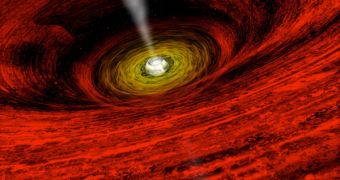Trying to find an answer to the essential question – which came first, the black holes or the galaxies – is like trying to figure out if the chick came before the chicken. This has remained a mystery for a very long time, and has also sparked numerous controversies among astronomers. Now, a new theory seems to be taking a foothold in the community, namely one that states that black holes existed at the beginning, before galaxies were even formed.
This belief has been prompted by the fact that the numerous supermassive black holes that exist at the center of each galaxy are simply too large in some cases to have evolved with it, seeing how those galaxies are still considered to be as young as 2 billion years. If the two were to have formed at the same time, the black hole would have been far smaller.
The study also shows that, early in the Universe, a few billion years ago, the black holes were still there, feeding on gases and other such “food” sources. In fact, a part of the new theory says that one possible source for the formation of black holes might have been the giant gas clouds, which could have contracted so much that their centers became the black holes. The remaining gases would have formed the galaxies around the holes.
Scientists from the National Radio Astronomy Observatory in Socorro, New Mexico, led by Chris Carilli, have discovered that, in some galaxies approximately 4 billion-years old, the supermassive black holes in their centers were as large as 20 billion Sun masses, which is roughly as large and heavy as the most powerful celestial bodies known in astronomy to date. But the fact that the observed ones had the same properties when the others were still stars prompted the need for a new approach to the matter.
Another point of view on how the holes came to be is through the “regular” channels, the collapses of stars. However, that would mean that the stars themselves were surrounded by the right amount of gases and other “nutrients,” in order to allow the black holes to grow at such massive speeds. “This suggests the black holes came first,” Carilli concludes.

 14 DAY TRIAL //
14 DAY TRIAL //